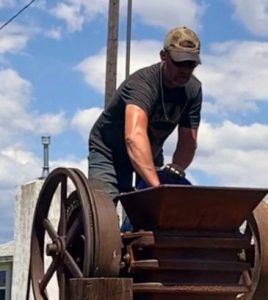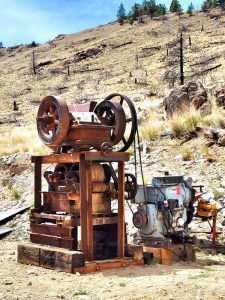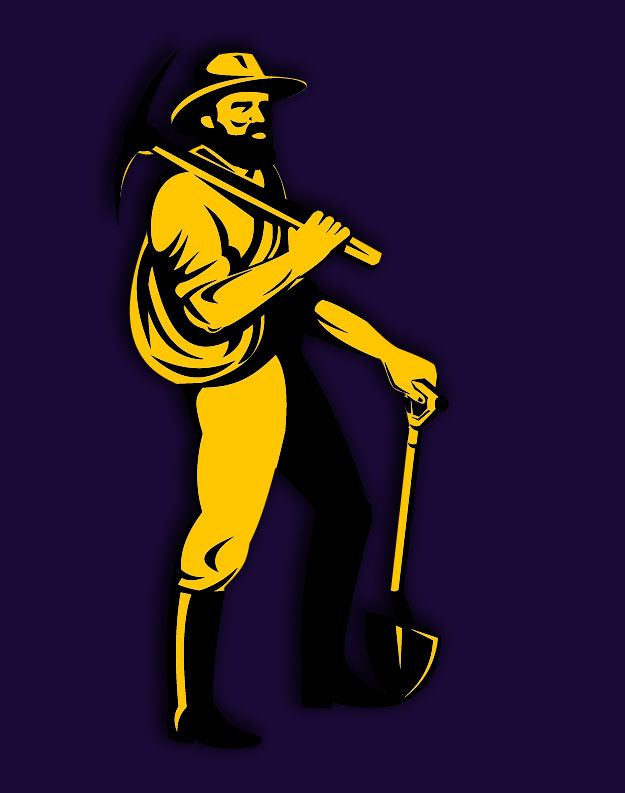Gold Mining Equipment For Sale
Definition of Gold Mining Equipment
 Gold mining equipment like a Stutenroth Impact Mill encompasses a wide range of tools that are specifically designed for gold prospecting and extraction. These tools vary in complexity, size, and functionality, catering to different scales of mining operations – from small-scale artisanal miners to large commercial operations. Gold mining equipment can include handheld tools like gold pans and classifiers for initial prospecting, as well as sophisticated machinery like dredges, trommels, rock crushers, and shaker tables for more efficient extraction processes.
Gold mining equipment like a Stutenroth Impact Mill encompasses a wide range of tools that are specifically designed for gold prospecting and extraction. These tools vary in complexity, size, and functionality, catering to different scales of mining operations – from small-scale artisanal miners to large commercial operations. Gold mining equipment can include handheld tools like gold pans and classifiers for initial prospecting, as well as sophisticated machinery like dredges, trommels, rock crushers, and shaker tables for more efficient extraction processes.
Importance of Using Proper Equipment in Gold Mining
The importance of using proper equipment in gold mining cannot be overstated. While it is true that gold can be found with minimal tools such as basic pans or even by using only your hands in certain circumstances, having specialized equipment significantly increases your chances of success. Properly designed and reliable equipment not only enhances efficiency but also ensures safety during every step of the mining process.
Overview of the Different Types of Gold Mining Equipment Available
The world of gold mining offers a vast array of specialized equipment options tailored to specific needs and conditions. Basic tools for gold prospecting include indispensable items such as gold pans – shallow wide-bottomed bowls with riffles along their sides – which help separate heavy particles from lighter materials like soil or sand.
Classifiers are also essential; these screens with varying mesh sizes allow miners to filter out larger rocks or debris before proceeding with further processing. For more advanced gold mining operations, sluice boxes and high bankers come into play.
These larger-scale tools use water and gravity to separate gold from sediments and gravels. Metal detectors are also commonly used to identify gold-bearing areas by detecting the presence of metallic minerals beneath the surface.
These are just a few examples of the many types of equipment available for gold mining purposes. Further sections of this article will delve into niche subtopics, rare details about specific equipment, safety considerations, and factors to consider before purchasing mining equipment.
High-level overview of gold mining equipment
Basic tools for gold prospecting
Gold prospecting is an exciting and rewarding activity that requires the use of specific tools to increase the chances of finding valuable deposits. The basic tools for gold prospecting include gold pans, classifiers, sluice boxes, and metal detectors. These essential equipment pieces allow miners to effectively search for gold in various types of terrain.
Gold pans and classifiers
A gold pan is a shallow, round-shaped dish typically made of metal or plastic. Its design allows for easy manipulation and swirling to separate heavy materials from lighter ones. When using a gold pan, miners scoop up sediment-rich material from rivers or streams and then gently swirl the contents.
By doing so, the heavier particles, such as gold or black sand, sink to the bottom while lighter debris like gravel and leaves wash away. Classifiers are used in conjunction with gold pans to further refine the material being processed.
These screens consist of a fine mesh that helps separate larger rocks and debris from finer sediments containing potential traces of gold. Classifiers come in different sizes based on the desired level of filtration.
Sluice boxes and high bankers
Sluice boxes are long rectangular devices used to capture larger amounts of sediment during the process known as sluicing. They are typically made of wood or metal and contain riffles strategically placed along their length.
As water flows through the sluice box, it creates turbulence that causes heavier materials, including gold particles, to settle into these riffles while lighter debris washes away. High bankers are elevated versions of sluice boxes designed for use in areas with more abundant water supplies or when working in a stationary position for extended periods.
They are constructed with an additional hopper at one end where miners can deposit large amounts of material to be processed. The water flow is controlled, and the process of capturing gold remains similar to using a traditional sluice box.
Metal detectors
Metal detectors are invaluable tools for modern-day gold prospectors as they help locate buried treasures beneath the surface. These handheld devices emit electromagnetic signals that interact with metallic objects present in the ground, indicating their presence to the user.
Metal detectors come in various models with different features such as adjustable sensitivity, discrimination settings, and waterproof capabilities. When searching for gold with a metal detector, prospectors carefully scan the ground, listening for distinct audio signals or observing visual indicators on the detector’s display.
This allows them to identify potential targets such as nuggets, flakes, or even larger underground deposits. Metal detectors greatly enhance efficiency by helping miners focus their efforts on areas more likely to contain valuable gold deposits.
Basic tools for gold prospecting include gold pans and classifiers which are used together to separate heavy particles from lighter sediments. Sluice boxes and high bankers provide larger-scale sediment capture and separation methods through the use of water flow and strategically placed riffles.
Metal detectors play a crucial role in locating buried treasures by detecting metallic objects beneath the surface. These essential tools lay a solid foundation for successful gold mining endeavors.
Niche Subtopics on Specialized Gold Mining Equipment
Dredges and Suction Dredges
Dredges have long been a vital tool in gold mining, particularly in extracting gold from riverbeds or streams. These ingenious machines work by removing sediment and gravel from the bottom of a water body, using a suction system that sucks up the material through a hose. Once the material is collected, it is then processed to separate the valuable gold particles.
When it comes to choosing a dredge for your mining operation, it’s essential to consider various factors such as the size of the water body you’ll be working in and the depth at which you expect to find gold deposits. Different types of dredges are available to suit different mining conditions.
For instance, if you’re operating in shallow waters with minimal sediment, a small suction dredge may be sufficient. However, if you’re tackling larger bodies of water with substantial deposits, opting for larger and more powerful dredges with robust suction capabilities would be more appropriate.
Trommels and Wash Plants
Trommels play an integral role in separating gold-bearing materials during mining operations. These cylindrical drum-like screens rotate as miners feed unprocessed material into them. As they rotate, smaller particles fall through while larger rocks and debris are ejected at the end of the trommel.
The primary purpose of trommels is to process large volumes of soil or gravel efficiently by separating out finer gold particles. When considering purchasing a wash plant for optimal gold recovery, there are several features to keep in mind.
The size and capacity of the trommel should match your intended production levels – too small may result in inefficiency while too large can become costly if not fully utilized. Other aspects worth considering include durability, ease of maintenance, water usage efficiency, and mobility if you anticipate moving your operation frequently.
Rarely Known Small Details about Specific Pieces of Equipment
Gold Shaker Tables
Gold shaker tables are perhaps one of the lesser-known, but highly effective, pieces of equipment used in gold mining. These specialized tables use gravity and vibration to separate fine particles of gold from heavier materials.
The table’s surface is typically lined with riffles or grooves that create turbulence in the water flow, allowing the dense gold particles to settle while lighter material is washed away. One advantage of using shaker tables is their versatility, as they can be used for both small-scale and large-scale mining operations.
They are particularly useful for capturing fine gold that may be missed by other methods. However, it’s important to note that shaker tables do have limitations.
They require a stable water source and careful adjustment to achieve optimal separation efficiency. Additionally, they may not be suitable for processing large quantities of material due to their relatively low throughput capacity.
Rock Crushers
 In the extraction process of gold mining, rock crushers play a crucial role in breaking down larger rocks into smaller fragments that can be further processed for gold recovery. There are various types of rock crushers available that serve different purposes depending on the desired final product size and production requirements. For example, jaw crushers are commonly used for primary crushing as they can handle large rocks efficiently.
In the extraction process of gold mining, rock crushers play a crucial role in breaking down larger rocks into smaller fragments that can be further processed for gold recovery. There are various types of rock crushers available that serve different purposes depending on the desired final product size and production requirements. For example, jaw crushers are commonly used for primary crushing as they can handle large rocks efficiently.
Cone crushers, on the other hand, are well-suited for secondary or tertiary crushing stages when finer-sized material is required. Impact crushers provide a more versatile approach by allowing both primary and secondary crushing in a single machine.
When choosing a rock crusher for specific mining needs, factors such as the hardness and abrasiveness of the rocks being processed should be considered. Additionally, factors such as power requirements, maintenance accessibility, and cost-effectiveness ought to be taken into account to ensure optimal performance and overall operational efficiency.
Safety Considerations when Using Gold Mining Equipment
Importance of Wearing Protective Gear
When engaging in gold mining activities, wearing appropriate protective gear is of paramount importance. Essential protective equipment includes gloves, goggles, and helmets. Gloves provide hand protection from sharp objects, chemicals, or potential injuries during manual handling of heavy equipment or materials.
Goggles shield the eyes from airborne particles, harmful chemicals, or splashing liquids that may cause eye injuries. Helmets offer head protection in case of falls or accidents involving falling objects.
Tips for Safe Operation and Maintenance
To ensure a safe working environment and prevent accidents or injuries when using gold mining equipment, it is crucial to follow some key tips for safe operation and maintenance. Regularly inspecting equipment for any signs of wear or damage is essential to identify potential hazards before they escalate. Following manufacturer guidelines for proper use and maintenance can help prolong the lifespan of the equipment and reduce the risk of malfunctions.
Additionally, implementing proper training programs for operators to familiarize themselves with the equipment’s controls and safety features can significantly contribute to accident prevention. Promoting a safety-conscious culture within the mining operation by encouraging open communication about potential hazards and near misses among team members further enhances overall safety.
Factors to Consider Before Purchasing Gold Mining Equipment
Budget Considerations
Before purchasing gold mining equipment, it’s crucial to establish a clear budget outline that aligns with your financial capabilities. Evaluate your available funds while considering both upfront costs and long-term expenses associated with maintenance, repairs, fuel consumption, and replacement parts if necessary.
Consider conducting thorough research on different suppliers to compare prices without compromising on quality and durability. It may be worthwhile to consult industry experts or experienced miners who can provide valuable insights regarding cost-effective options that suit your specific needs.
Conclusion
In the world of gold mining, having the right equipment is essential for successful operations. Specialized equipment such as dredges and suction dredges, trommels and wash plants, gold shaker tables, and rock crushers play significant roles in extracting gold effectively.
However, it’s crucial to prioritize safety by wearing protective gear and following proper operation and maintenance procedures. Before making a purchase decision, carefully consider budget constraints while ensuring that the chosen equipment aligns with your specific mining requirements.
Investing in quality equipment will not only enhance productivity but also contribute to a safer working environment. With the right combination of knowledge, preparation, and investment in suitable equipment, aspiring gold miners can embark on their journeys towards prosperous ventures.
